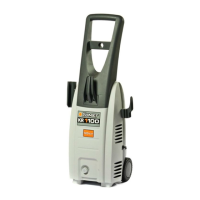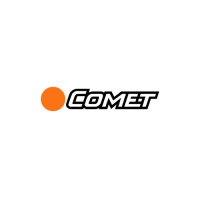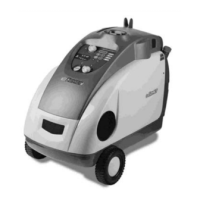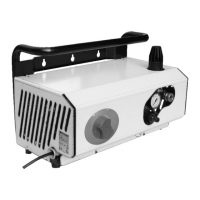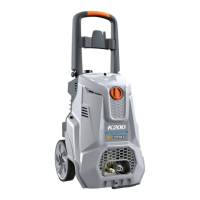25
EN
5.1 prelImInary procedures
• Pipe reel (11): turn the ring nut (10) anti-clockwise to release the device; unroll the amount of pipe
required by turning the reel anti-clockwise using the knob (12); turn the ring nut (10) clockwise to
block the device.
• Attach a supply pipe to the water inlet’s quick connection (16) using a normal garden connector.
Operation D in Fig. 5.
• Open the tap to the water supply and make sure that there are no drips. Operation E in Fig. 5. Otherwise,
prime using an appropriate tank.
• Make sure that the main switch (1) is in the o position (the ‘0’ position) and put the plug into the
electric current outlet. Operation F in Fig. 5.
• Turn the main switch (1) to position ‘1’.
• Press the cleaner gun’s control lever (33) and wait for a continuous jet of water to be issued.
• Note 3: the Total Stop function is not operational in this condition because the operating pressure is less
than 20 bar / 290 psi (also refer to the “Interrupting use when operating pressure is between 0÷20
bar/0÷290 psi” section).
• Turn the main switch (1) to position ‘0’ and connect the lance pipe (21) to the cleaner gun (19).
OperationG in Fig. 5.
5.2 standard operatIon (hIgh pressure)
• Make sure that the nozzle head (23) or (24) is not in the position for supplying detergent (also see the
“Use with detergents” section).
• Restart the high pressure cleaner by turning the main switch (1) to position ‘1’ and check that the spray
from the nozzle is uniform, without dripping.
• Note 4: during this restart phase, the high pressure cleaner will immediately stop operating aer the
initial peak, as the Total Stop device will take eect.
• Use the cleaner gun’s lever (33) to start operation of the high pressure cleaner and thus start cleaning.
• Adjust the pressure, if necessary, using the pressure adjustment control (17). Turn this knob clockwise
to increase pressure and anticlockwise to reduce pressure. e amount of pressure is shown on the
pressure gauge (18)
5.3 use wIth detergents
WARNING
• e high pressure cleaner was designed to be used with the detergents recommended by the Manufacturer.
Use of other detergents or chemicals can aect the safety of the high pressure cleaner.
Never suck up liquids, which contain solvents, petrol, diluents, acetone and fuel oil, as these products are
highly inammable, explosive and toxic when nebulized.
• Read the instructions and warnings on the label of the detergent to be used.
• Store detergents in a safe place out of children’s reach.
• Should detergent come into contact with your eyes, wash immediately with water. Contact a doctor
without delay and remember to take the container of detergent with you.
• If detergent is swallowed, do not provoke vomiting. Contact a doctor without delay and remember to take
the container of detergent with you.
• When lling the tank with detergent, take care not to spill any detergent on the high pressure cleaner. If
this should happen, wait at least 24 hours before using the high pressure cleaner so that any liquid, which
may have entered the appliance, can evaporate.
e recommended detergents, are over 90% biodegradable.
For information on how to use the detergents, refer to the instructions in the table and on the label on
the container of detergent.
• If using suction from the high-pressure cleaner’s tank (5), unscrew the cap (3) and ll the tank taking
care not to spill the liquid (maximum capacity 4L / 1.06 US gallons). Follow the recommendations
regarding the doses indicated on the label on the container of detergent.
For more thorough cleaning, the detergent tank (5) can be removed from its housing as follows:
• Unscrew the ring nut (6) completely, remove the detergent suction pipe (37), press down on the detergent
cap (3) and remove the tank (5) at the same time.
Follow the same procedure backwards to replace the tank.
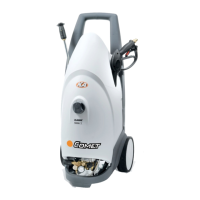
